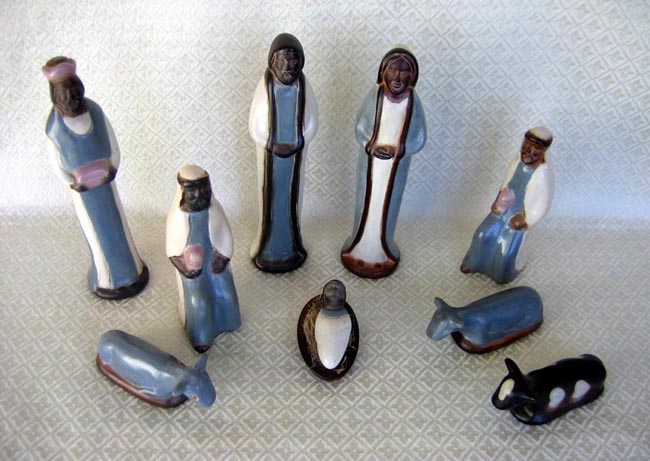OUR COLLECTION — LATIN AMERICA — PERU 104. TALL BLUE CHULUCANAS NATIVITY
This clay Nativity set from Chulucanas Peru includes the Holy Family, three wise men with gifts, two blue donkeys and a brown spotted cow. The standing figures measure 11 inches tall.
Clay pottery from Chulucanas, a small town on the north coast of Peru, is uniquely created. First, the piece is formed using several techniques: paddling, rolling, tableting, and using a wheel or an extruder. The artist is this set, José Sosa, shapes his pottery using a small stone, a wooden paddle, and the inner sole of his foot. Once shaped and in a leathery state, the piece is painted with a slip made from clay and pigment. Then comes the burnishing or polishing which includes rubbing the entire visible surface with river stones of several forms and sizes to obtain a fully satin and homogenous surface. This operation is repeated three times and requires great skill so that the piece will not be damaged or cracked. Once dry, the figure is stacked in the wood-fired kiln and heated to a temperature of approximately 700 to 900 degrees centigrade.
The next step is the decoration, or slip casting, in which liquid clay is used to cover the areas that are to be kept intact, while the areas the potter wishes to darken are left uncovered. This method is knows as “reverse.” The decorated piece is then loaded into the smoke kiln where burning mango leaves will produce smoke that will darken the piece. A resin is also applied that adheres to the piece, giving it the characteristic brilliance of the Chulucanas style. This firing is done two or three times until the desired shade of brown or black is obtained. The pieces are then cleaned to remove the slip and a final finish wax is applied to highlight the impeccable satin characteristic.
Clay pottery from Chulucanas, a small town on the north coast of Peru, is uniquely created. First, the piece is formed using several techniques: paddling, rolling, tableting, and using a wheel or an extruder. The artist is this set, José Sosa, shapes his pottery using a small stone, a wooden paddle, and the inner sole of his foot. Once shaped and in a leathery state, the piece is painted with a slip made from clay and pigment. Then comes the burnishing or polishing which includes rubbing the entire visible surface with river stones of several forms and sizes to obtain a fully satin and homogenous surface. This operation is repeated three times and requires great skill so that the piece will not be damaged or cracked. Once dry, the figure is stacked in the wood-fired kiln and heated to a temperature of approximately 700 to 900 degrees centigrade.
The next step is the decoration, or slip casting, in which liquid clay is used to cover the areas that are to be kept intact, while the areas the potter wishes to darken are left uncovered. This method is knows as “reverse.” The decorated piece is then loaded into the smoke kiln where burning mango leaves will produce smoke that will darken the piece. A resin is also applied that adheres to the piece, giving it the characteristic brilliance of the Chulucanas style. This firing is done two or three times until the desired shade of brown or black is obtained. The pieces are then cleaned to remove the slip and a final finish wax is applied to highlight the impeccable satin characteristic.
